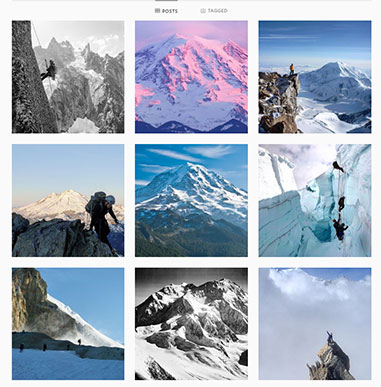Course Overview
I absolutely enjoyed the Cascades Intermediate Climbing course. This course was by far the best, most adventurous and enjoyable course I have taken from Alpine Ascents. I would recommend this class to all of my friends and fellow climbers looking for a rewarding, difficult, demanding and more technical adventure with amazing objectives.
>>See More
The 8-Day Intermediate Mountaineering course is an incredible opportunity to learn advanced alpine climbing topics in North Cascades. The focus of the course is climbing steep snow, rock and mixed terrain, in addition to glacier travel. The wilderness of the North Cascades provides the ideal training ground due to the variety of terrain that is available. The goal of this course is that graduating students should be able to climb non-technical glaciated mountains with short sections of moderately technical terrain competently. It also provides excellent advanced preparation for guided ascents of the Kautz on Mount Rainier, the Matterhorn, Denali, Mount Vinson and Cho Oyu. Alpine Ascents believes the best training for mountaineering is accomplished with as much time in the field as possible, and all eight days are spent in the mountains.
Course Objectives
Complete a series of climbs designed to improve and increase existing mountaineering skills and knowledge.
To further develop experienced climber’s existing technical skills.
Climbing techniques covered:
- Crevasse rescue review
- Advanced crevasse rescue topics
- 3rd/4th class rope systems
- Placement of protection for snow / rock climbing
- Lead climbing
- Rappelling
- Risk management
- Route finding / trip planning
- Wilderness navigation (map, compass, GPS)
This course has been successfully used as a training ground for skilled adventurers, rangers, law enforcement, fire fighters, military, stunt people and many others who require climbing skills as part of their career.
The first half of this course typically takes place in Washington Pass and the last half in Boston Basin. We utilize a variety of locations to distribute land use and provide pristine, less populated environs for our training. It also enables us to take advantage of the best possible mountain conditions for each course.
The North Cascades
The North Cascades in Washington state form the largest and most rugged alpine wilderness mountain range in the contiguous United States. Contained within this range are scores of peaks topping 8,000 feet, upwards of 400 glaciers, and countless permanent snowfields. Most of the high peaks in the North Cascades are composed of metamorphic or intrusive igneous rocks. These weather-resistant rocks have been heavily sculpted by alpine glaciation, producing stunning peaks and ridges. These breathtaking views and the wide variety of alpine climbing have earned the area the nickname “The American Alps.” The North Cascades are considered the premier training ground for developing alpine climbers. See our Course Catalog for a complete listing of our North Cascades course offerings.
The weather in the North Cascades can be extremely variable, with snow below 3,000 feet. Precipitation levels are heavy, particularly during the winter months. “Variable conditions” also include glorious weather for lengthy periods, usually in late summer. For instructional purposes, the optimum time to climb in the Cascades is from early May through late August. This is when the combination of weather and snow conditions is usually at its best.
The vegetation and wildlife of the North Cascades are interesting and diverse. Approximately 150 common species and another 100 or so less common species of wildflowers bloom during the summer. This range is aesthetically exceptional and we hope you find yourself returning many times to enjoy its grandeur.
Many who have been introduced to the world of alpine climbing in the Cascades have gone on to climb in the world’s greatest mountain ranges. We hope our program will be the first step towards a lifetime of mountaineering.
Cascades Summit Details
Liberty Bell (7,720 ft.) is an iconic granite spire in the Pacific Northwest and we typically climb it via the ultra classic Beckey Route. This route has 4-5 pitches of technical climbing up to 5.6, which leads to a short bit of moderate terrain just below the top.
Sharkfin Tower (8,120 ft) is an impressive 800′ granite spire that towers high above the Quien Sabe Glacier in Boston Basin. Sharkfin Tower features good rock with excellent exposure and in an unbeatable setting. To reach the summit, students must surmount steep snow and 5th class alpine rock.
Forbidden Peak (8,816′) is an exceptional alpine climbing objective. It combines glacier travel, steep snow, and beautiful rock/mixed climbing to the most classic summit in the range. In fact, the West Ridge of Forbidden Peak is one of the “Fifty Classic Climbs of North America” as compiled by legendary alpinists Steve Roper and Allen Steck.
Sahale Peak (8,680 ft.) presents another classic North Cascades wilderness mountaineering objective and is a favorite among our guides. Climbers are rewarded with some of the best scenic views in the range. The corniced rock and snow summit ridge rises above the small, steep Quien Sabe Glacier and provides an aesthetic climbing line that’s accessible with basic skills.
This is a highly recommended shortlist and we would be happy to pass on a longer reading list for those interested. These links will bounce to Amazon.com with reviews.
Glacier Travel & Crevasse Rescue
Andy Selters, Mountaineers Books
The Illustrated Guide to Glacier Travel & Crevasse Rescue
Andy Tyson, Mike Clelland, Climbing Magazine
Mountaineering: Freedom of the Hills
Don Graydon (Ed.), Kurt Hanson (Ed.), Mountaineers Society, Mountaineers Books
Rock Climbing: Mastering Basic Skills
Topher Donahue, Craig Luebben, Mountaineers Society, Mountaineers Books
Definitely enjoyed the course. The instructors were great, I feel I learned a lot and solidified skills I was shown in the past. I feel ready to use the skills I learned on future climbs or courses.



